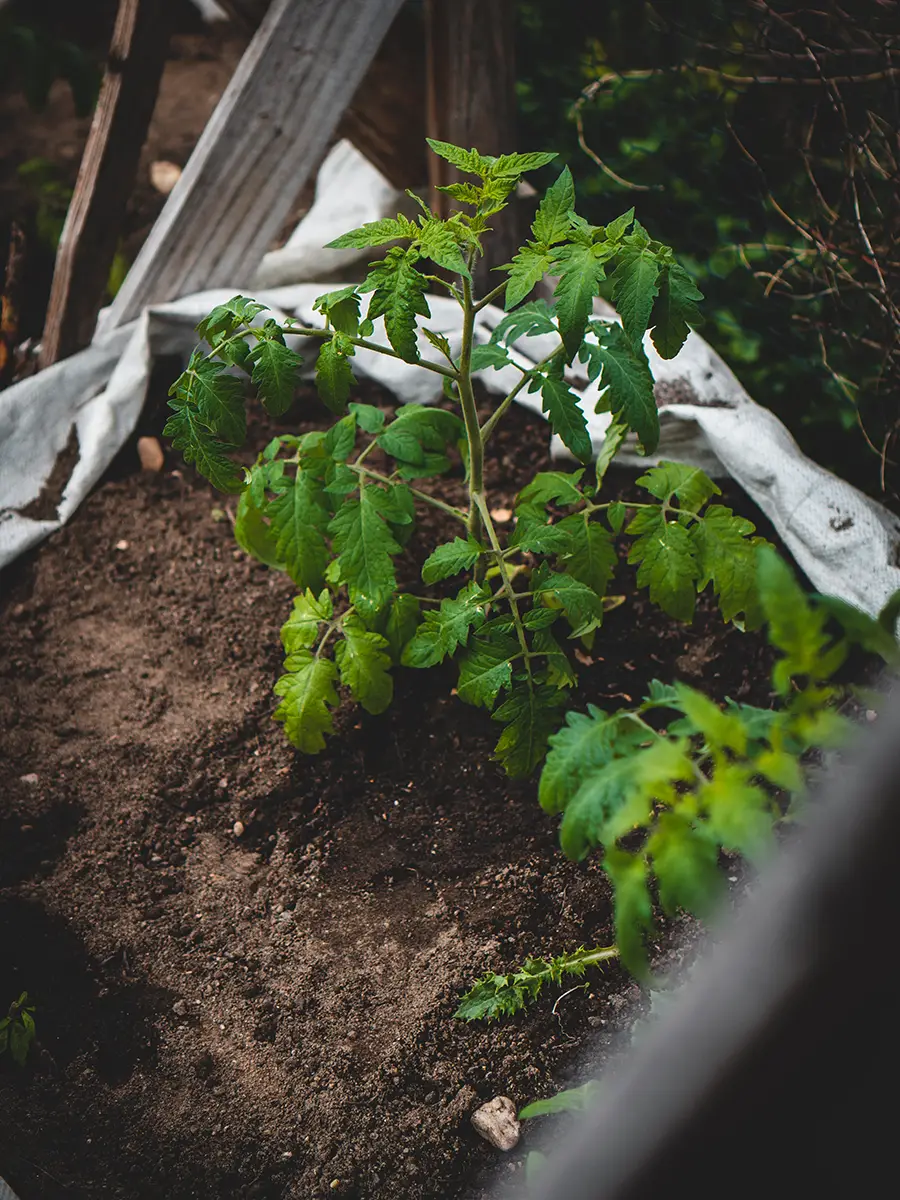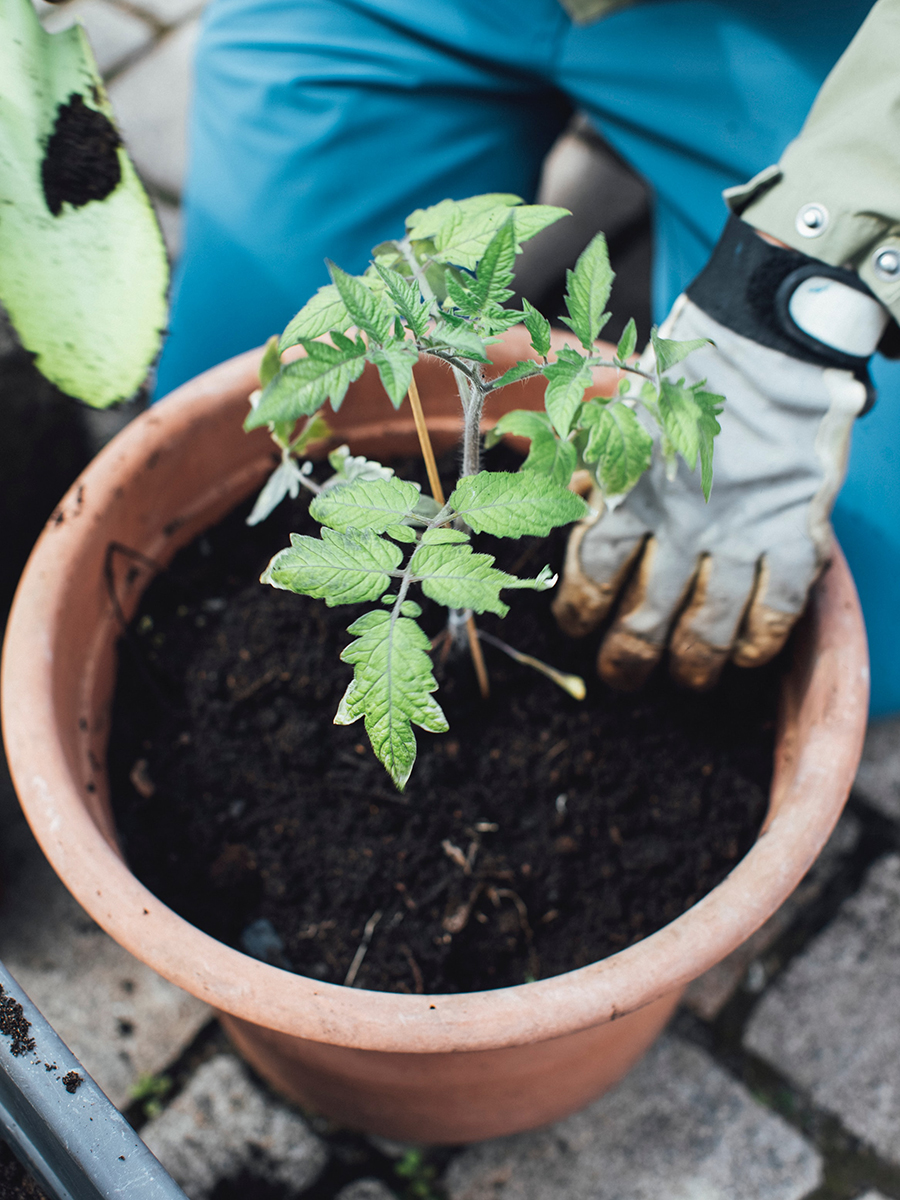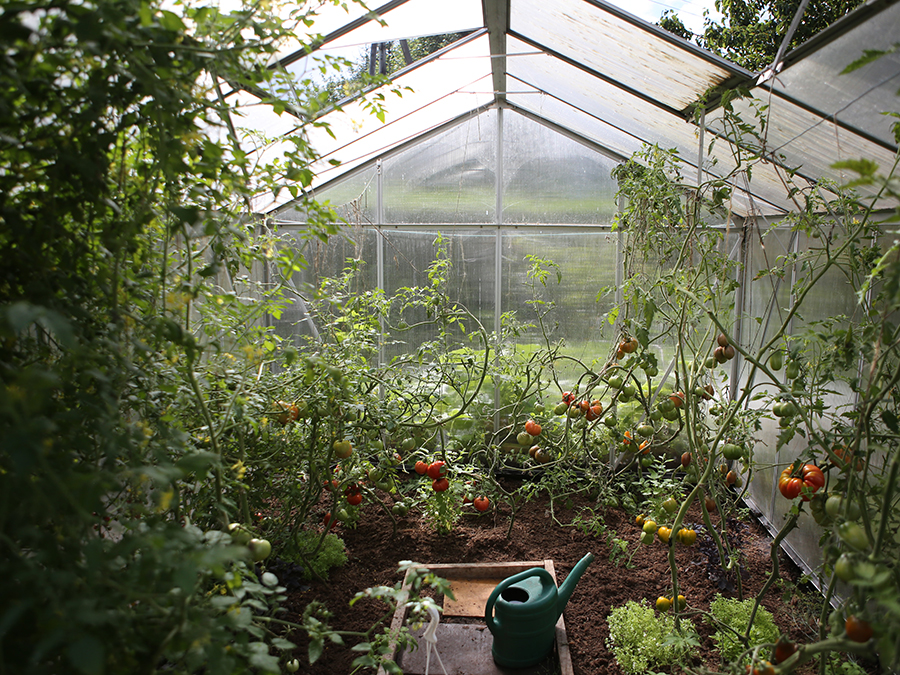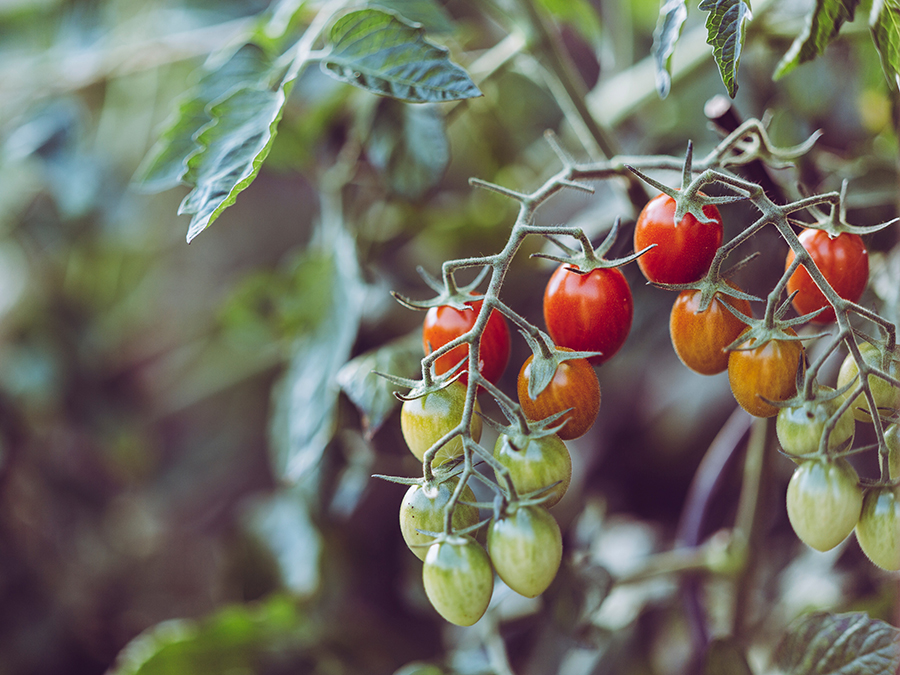Plum Tomatoes — Roma vs Plum + How to Grow Them in Any Weather

Plum tomatoes are a category of tomatoes that are best for making rich tomato sauce and paste. Plum tomatoes have a thicker fruit wall, finer seeds, and less moisture making them particularly suited to making tomato sauce and paste. Some of the most famous varieties of plum tomatoes are the Roma, San Marzano, Ropreco Paste, Amish Paste, and the Big Mama.
- Plum Tomato Quick Facts
- Botanical Name—Solanum Lycopersicum
- Common Names—Plum tomatoes, sauce, canning, or processing tomatoes, Roma tomatoes, Italian tomatoes
- Plant Type—annual fruit, though it can be a perennial in tropical climates
- Size—determinate bush varietes 2 to 4 feet tall, indeterminate vine varietes 6 to 8 feet tall
- Spacing—⅛ inch deep, 24 inches between plants, provide a trellis or stake and twine
- Ideal Climate—full sun, 75-95 F
- Can it Be Started Indoors and Transplanted—yes
- Taste—rich and meaty, slightly acidic, best in sauces
- Growth—55 to 80 days to maturity
- Harvesting—fruit is firm with a little give and can be gently plucked off the vine when ripe
Are Roma and Plum Tomatoes the Same Thing?
You may be wondering if Roma and plum tomatoes are the same things since the words seem to be used interchangeably. Plum tomatoes are the parent category, while Roma tomatoes are a variety of plum tomatoes.
Both tomatoes labeled as Roma and Plum can be used interchangeably in recipes like pasta and pizza sauce, as both make excellent sauce or paste tomatoes due to their thick meaty walls, soft seeds, and low moisture content.
To clear up the tomato confusion further, it is helpful to know that there are three basic categories of tomatoes. Cherry, slicing/sandwich, and plum/paste. So the plum/paste category can refer to the Roma tomato, as well as many other varieties.
Where Do Plum Tomatoes Come From?
Each variety of Plum tomato has its own unique history. The San Marzano, for example, is the traditional Italian plum tomato. It was introduced by an Italian seed house in 1926 and found its way to America in 1930.
In the 1950s the Roma variety of plum tomato was developed by USDA researchers to be resistant to Verticillium and Fusarium wilts which were a common problem in its predecessors. It was bred from the San Marzano and the Pan American tomatoes. This was coined the Roma VF, to signify its hardiness against wilting diseases, and now is the most commonly produced sauce tomato in the world.
Each time you grow tomatoes at home, you are a beneficiary of hundreds, if not thousands of years of tomato cultivating and breeding for the very best characteristics.

How Do I Plant Plum Tomatoes?
Seeds—The plum tomato plant can be started indoors six weeks before the last frost date. If you live in a warmer climate with a longer growing season, you can sow your seeds directly into the ground or in a raised bed garden after the danger of frost is gone.
They do well when daytime temperatures have reached at least 70 to 75 F. And they love the even hotter temperatures up to 95 F. My grandfather swears by a ground temp thermometer to let him know when it’s time to plant. Plum tomato seeds like warm weather, and won’t germinate in soil less than 65 F.
Plant your seeds ⅛ inch deep and about 24 inches apart, or follow the planting instructions on your seed packet. The seeds will generally germinate in 7 days but can take up to 14 days to germinate depending on your soil temperature. To help them germinate faster, you can use a heated seed mat for indoor seed starting or place them outside in a greenhouse.
Plum tomatoes thrive on 8 to 10 hours of direct sunlight each day so they need to be planted in an area with full sun. You can start your seeds indoors in a space with plenty of indirect sunlight. But once they’ve been hardened off and moved outdoors, you’ll need to transplant them in an area with full sun.
Watering—When you first plant your plum tomato seeds, whether in the ground or in containers indoors, you’ll need to water them frequently until they germinate. Anywhere from twice a day, to every other day, is good for watering seeds.
Decide how often to water by checking the moisture of your soil. You don’t want the soil around your seeds drying out completely, but you also don’t want to drown your seeds. Simply check the soil by sticking your finger to test the moisture and water accordingly. If more than the first two inches are dry, it’s time to water.
Once your seeds have germinated and are grown, about one to two weeks after planting, you can begin to water less often. It’s best to water an established garden more deeply and space waterings further apart rather than daily. In general, gardens can be soaked with 1 inch of water or rain once a week. If you get rain, you only need to supplement whatever amount of water is left up to 1 inch of rain.
Soil—Plum tomato plants need good drainage, so you’ll want to make sure you have a good mix of organic compost and high-quality topsoil. Perfect soil should be able to pass the squeeze test. If you squeeze it in your hand, it will hold together. But if you run your fingers through it, it will fall apart.
If your soil is too hard, consider amending it with compost to allow for better drainage and oxygen. If you are using raised beds or tilling soil into your inground garden bed, try one of these soil recipes. Remember, your garden will only be as good as your soil.
There are many different recipes for the best garden soil, but the two most popular are:
- 60/30/10—60% topsoil, 30% compost, and 10% potting soil (this is actually a soilless blend of peat moss, vermiculite, and/or perlite.
- 50/50—50% topsoil and 50% compost
When buying your topsoil, you’ll need to do a little sleuthing to make sure it’s good quality. Signs of high-quality topsoil are:
- Regionally sourced ingredients listed on the bag
- Nationally recognized compost certification on the bag
- Passes the squeeze test, sticks together when squeezed, but then falls apart again when you run your fingers through it
- Is not fill-dirt that some companies mistakenly call top-soil

Can I Grow Plum Tomatoes in a Cold Climate?
Yes, beautiful tomatoes can absolutely be grown in colder climates, with some modifications. If you live in a colder climate, especially one with a shorter growing season, you’ll want to start your seeds indoors, about 6 weeks before your last frost date.
You may be tempted to start your seeds even earlier, but we don’t recommend it as it can result in leggy tomato plants with long spindly roots that won’t grow well when transplanted.
Leggy tomato starts are the result of not enough light, and plants trying their hardest to reach up for as much light as possible. To prevent this, start your seed in a spot that gets plenty of indirect light. If you live in a very cold or cloudy climate, consider using indoor grow lights or a heated greenhouse. You can learn all about greenhouses and find ideas for small DIY greenhouses under $50 here.

How Long Do Plum Tomatoes Take to Grow?
There are variations for growing length in each type of plum tomato. In general, they will all take around 55 to 80 days from planting seeds until you’re ready to harvest. Tomato plants grow in several different ways, called determinate, indeterminate, and semi-determinate. Each type has different growth needs to growth rates.
Determinate—these are also called bush plants and will grow to a certain height, usually around 4 to 6 feet, and then stop growing. Their tomatoes will ripen all at once and earlier in the season, then stop producing after they are harvested. Most determinate tomato bushes do not need a cage or trellis to grow on.
Determinate varieties are great if you live in a small space and need a container garden. They are also popular with canners who want to make a big batch at once. Or if you want to go on a long vacation at the end of summer, your determinate types will allow you to do that.
The Roma VF is the most popular variety of determinate plum tomato. The Banana Legs tomato is another fun variety of determinate plum tomatoes that produces sweet bright yellow fruits.
Indeterminate—these varieties are more of a vining plant rather than a bush. They have been known to grow up to 15 feet high when given the trellis room to do so. But typically they grow between 6 to 8 feet tall. Indeterminate tomato plants will produce fruit more gradually and for much longer in the season than determinate types.
Indeterminate varieties are great if you want to harvest your plum tomatoes for canning sauce in smaller batches throughout the season. You can also use this gradual harvest of plum tomatoes sliced in salads, sandwiches, and salsa.
Indeterminate types will need strong trellising. The Big Mama and the Amish Paste are two of the most popular varieties of indeterminate vining plum tomatoes.
Semi-determinate—these varieties of plum tomatoes are a mix between a bush and vine, and can give you the best of both worlds. They are harvested semi-gradually and often do well with a trellis. Many gardeners like to grow multiple types of plum tomatoes to space out the harvesting. The San Marzano, the Italian tomato, is the most popular semi-determinate plum tomato.
Do I Need a Trellis for My Plum Tomato Plant?
For determinate types of plum tomatoes that grow like a bush, you do not need a trellis. This is especially helpful if you live in a small space and don’t have tons of room for a tall trellis.
Indeterminate and semi-determinate types of plum tomatoes do need a good strong trellis. The fruit is heavy and the vines can grow up to 15 feet tall. It will need a trellis to stay healthy, avoid fruit overload, and keep your harvest from growing on the ground and being stepped on.
Often a simple tomato cage is not enough for an indeterminate tomato plant. They really need more height and strength. We have found it better to use two stakes and to tie the shoots on them with garden twine weekly during the growing seasons. We also really like to use cattle panels on a homemade trellis to allow our tomatoes to grow big and tall.
How Do I Know When Plum Tomatoes are Ripe?
Plum tomatoes are ripe and ready to eat when they are firm with a little give and are easily plucked off the vine. Plum tomatoes will also continue to ripen even after being picked. You can choose to pick a pink but not yet red tomato and let it ripen on the counter, depending on when you plan to use it.
It’s best to pick your tomatoes with clippers rather than pulling, which can potentially damage your plum tomato vines or knock off green tomatoes. Be sure to pick your tomatoes before they become overripe, or they may attract unwanted pests and sun damage.
If you have indeterminate plum tomatoes, you’ll want to keep up with the harvesting so your plant doesn’t become overloaded and stop producing.

Can I Save Plum Tomato Seeds?
You can propagate your own plum tomato seeds for next season. It’s simple and will save you from buying seeds the next year. Simply follow these steps to save tomato seeds.
- Use this process only for heirloom varieties that are not hybrids, and choose your best-looking tomatoes
- Cut them in half and separate the meat from the seeds and place the seeds in a jar of water for 2 to 4 days
- Allow a solid lay of mold to grow on top as the mixture ferments and the seed coating is dissolved
- Discard everything else and rinse the good seeds
- Dry your saved seeds in a single layer on a paper plate or glass plate and save them in an envelope to use the following year
How Do I Eat a Plum Tomatoes?
The beautiful thing about Plum tomatoes is that they can be substituted for almost any other category of tomato. The opposite isn’t true of cherry or slicing tomatoes. Plum tomatoes really shine when made into a sauce or paste, because they have thick meaty walls, fewer seeds, and less water.
But in a pinch, you could use plum tomatoes like you would sliced tomatoes. In a sandwich, burger, or in salsa. You could also use plum tomatoes in a salad as you would cherry tomatoes. Because the plum tomato family is so versatile, if you only have space or time to grow one kind of tomato, let it be the plum.
Ready to get started gardening or need help troubleshooting your own garden? Check out The Complete Guide to Gardening at Home + 5 Beginner Mistakes to Avoid.
How about you, have you grown plum tomatoes before? Which variety have you liked the best? Let us know your experience in the comments below.

Leave a Reply